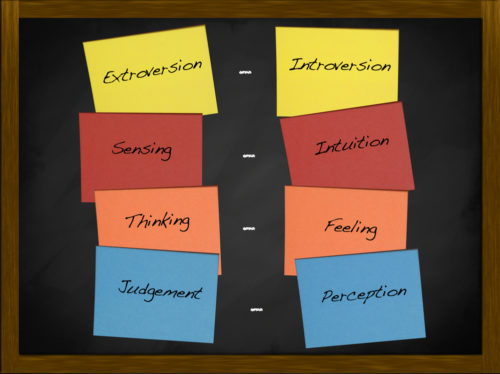Your personality is an essential part of your humanity. It is a combination of characteristics that can define how you interact with the world around you, make decisions, respond to stimuli or stress, and build and maintain your relationships. Personality can also have a major effect on your career, as your personality can explain why some jobs are uninteresting and tiring, and why other jobs feel like your true calling.
Learning more about your personality can be an important soft skill, as you can use that knowledge to pursue better career opportunities, or work on identifying and improving your weaknesses.
Over time — and throughout your lifetime — you may find that your personality changes slightly depending on your personal experiences and worldview. It could be that in five years from now you’re no longer as judgmental, or less likely to act immediately on your emotions. These changes could be subtle, but show how you can grow, change, and adapt throughout your lifetime.
There are many different ways to discover your personality. You can take a variety of free online personality tests — each with a different approach to defining your characteristics, strengths, and weaknesses. For the most part, the results may appear similar, but each test might have a different explanation that sheds further light on your personality.
However, one of the most common personality tests in the United States goes by a variety of names: the Carl Jung Typology, 16-Personalities test, or Myers-Briggs Type Indicator (MBTI) assessment. All of these tests are based on the research of Carl Jung, and each might ask a different series of questions, but all should have a similar answer which will result in one of sixteen acronyms that will define your personality type.
The MBTI assessment is a useful one for understanding your personality and defining your strengths and weaknesses. However, it also has its flaws. Let’s look at what this test says about you, the pros and cons of the test, and how you can find a reliable version to take online for free.
Table of Contents
What Is the Myers-Briggs Personality Type Indicator (MBTI)?
The MBTI started as a curiosity project in 1917 by Katharine Cook Briggs, who was attempting to better understand and define personality types. She initially was able to define four personalities: meditative (or thoughtful), spontaneous, executive, and social. She later came across a more complete version of her personality research, via the conceptualized theory of Swiss psychologist, Carl Jung, in the 1923 English translation of Psychological Types.
Katharine Briggs’ daughter, Isabel Briggs Myers, eventually joined her mother in researching personalities, and later took over the project entirely. Both Briggs and Myers-Briggs were exceptional writers in their own right, and Myers-Briggs was well known for her mystery novels which utilized typology theories to create characters and plotlines.
Neither Briggs nor her daughter were formally educated in the theories of psychology, but they both devoted years of researching and reading the works of psychologists such as Jung. Overtime, Myers-Briggs also learned basic test construction, scoring, validation, and statistical methods from a personnel consulting firm that she started alongside Edward N. Hays.
Together, the mother and daughter duo were able to take Jung’s ideas about personalities and place them into sixteen different personality types. Briggs initially presented Jung’s ideas in a newspaper article she wrote in 1926. However, the actual MBTI assessment wasn’t created until the start of World War II for America: 1944.
The original intention of the Briggs Myers Type Indicator Handbook (1944) was to help women who were joining the workforce for the first time, as the influx of men joining the military required many women to take on newly vacated jobs. The hope was, women who took the MBTI assessment would have an idea of what jobs would be “most comfortable and effective” for their personality. The name of the test then officially changed to the name we know today in 1956: the Myers-Briggs Type Indicator. The test was praised by some psychologists, criticized by others, and many members of the public were hooked on this creative and fairly new concept to finding job compatibility.
Myers-Briggs Personality Types and Detailed Explanations
The MBTI looks at the following criteria:
- How you focus your attention or re-energize (extraversion (E) / introversion (I))
- How you perceive or take in information (sensing (S) / intuition (N))
- How you make decisions (thinking (T) / feeling (F))
- How you orient yourself to the outside world (judgment (J) / perception (P))
Based on the answer you give to specific questions (which vary, depending on which version of the test you’re taking), you will be given an acronym that may define your personality. The sixteen possible answers and their frequency according to the MBTI Manual are:
- ISFJ (about 13.8% of the population)
- ESFJ (about 12.3% of the population)
- ISTJ (about 11.6% of the population)
- ISFP (about 8.8% of the population)
- ESTJ (about 8.7% of the population)
- ESFP (about 8.5% of the population)
- ENFP (about 8.1% of the population)
- ISTP (about 5.4% of the population)
- INFP (about 4.4% of the population)
- ESTP (about 4.3% of the population)
- INTP (about 3.3% of the population)
- ENTP (about 3.2% of the population)
- ENFJ (about 2.5% of the population)
- INTJ (about 2.1% of the population)
- ENTJ (about 1.8% of the population)
- INFJ (about 1.5% of the population)
Applications of the MBTI Test
The knowledge gained from this assessment can be used for a variety of applications. One of the most common intentions is the original intention of the test: career assessment. However, there are plenty of other valid reasons:
- Career Aptitude: Whether you’re already in the workforce, or you’re a student looking to better understand how your talents can be applied to a career, taking the MBTI for career assessment can be helpful. It can help you identify your strengths and weaknesses, better your understanding of yourself and how you interact with others (whether coworkers, customers, or clients), and show you how to best apply your talents to a career path that you would find fulfilling. However, it’s important to remember that the results are not a concrete answer, and it’s very possible that some of the careers that best align with your personality type are not best for you.
- Relationships (Romantic or Friendly): Some personality types make for easier compatibility than others. That doesn’t mean that only INFJs can be friends with other INFJs, but it does mean you can use the information you gain to better understand why some people are harder to get along with than others. Self-awareness is an important soft skill to have, and learning about your own personality can help you become a better communicator or help you make stronger first impressions.
- Family and Parenting: Learning about your own personality can be helpful for yourself. However, learning about the personality of others (such as parents, children, or siblings) can help you better relate to the people you care about. Additionally, as a parent, you can more fully guide your child’s growth if you have a better grasp of their personality — whether they need disciplined guidance, or freedom to grow.
- Personal Growth: Knowing your personal strengths and weaknesses is essential to becoming a more well-rounded individual. The first step in improving your weaknesses or mistakes is becoming aware of them, and you can use the information you’ve gained to better understand why you do the things you do. Plus, taking the MBTI can help you define your life’s purpose outside of a career — whether that’s spending more time volunteering for charities, or being spontaneous and taking unplanned trips more often to feel fulfilled. Lastly, learning about yourself can help you gain valuable insight about your day-to-day life. You no longer have to beat yourself up over a personality trait that you don’t have, or you can better understand why certain conversations went wrong or caused stress. With the knowledge you gain, you can start improving small mistakes and live your life with more intention, fulfillment, and less stress.
Problems With the Myers-Briggs Personality Type Indicator Test
Just as with any other personality test or career aptitude assessment, the MBTI is not free from criticism. Many psychologists over the years have both praised the test, as well as highlighted its flaws. In general, the flaws are related to the inconsistent reliability of the test, as well as the often misleading assumption that the results of the test are akin to scripture: concrete types, with little room for flexibility due to changing characteristics.
Unfortunately, the test has been used in a negative way as well. Especially for students in high school who are trying to better prepare for their future; the MBTI is often used to put them into static career boxes. They may take the test and hope for a high-paying career option such as doctor or lawyer, and instead end up with kindergarten teacher or janitor. Although service jobs and teachers are extremely important, it can lower the self-esteem and hopes of young students when they’re given the assumption that the results of the test are constant or unchanged.
Plus, many people who take the test may not realize that the results can change over time, and some who believe heavily on the test may take the wrong approach to differing personalities, potentially making poor first impressions or discounting opinions simply because of that person’s MBTI results. Many hiring managers also use similar tests to the MBTI to find compatible employees for their business, but the test is unreliable and uneven in results, which can result in a poor qualifier for finding and hiring new employees.
A 2013 article from Fortune Magazine further explains some of the common criticisms of the MBTI assessment:
“The interesting — and somewhat alarming — fact about the MBTI is that, despite its popularity, it has been subject to sustained criticism by professional psychologists for over three decades. One problem is that it displays what statisticians call low ‘test-retest reliability.’ So if you retake the test after only a five-week gap, there’s around a 50% chance that you will fall into a different personality category compared to the first time you took the test.
“A second criticism is that the MBTI mistakenly assumes that personality falls into mutually exclusive categories. You are either an extrovert or an introvert, but never a mix of the two. Yet most people fall somewhere in the middle. If the MBTI also measured height, you would be classified as either tall or short, even though the majority of people are within a band of medium height.“The consequence is that the scores of two people labelled “introvert” and “extrovert” may be almost exactly the same, but they could be placed into different categories since they fall on either side of an imaginary dividing line.”
Jung Typology Theory
The MBTI assessment is heavily inspired by Carl Jung’s research into psychology and personality theory. However, Briggs and Myers-Briggs both took some liberties and added in their own personality indicators when creating their test. Part of this is due to Jung’s typology theory, which the mother-daughter duo did not agree with entirely.
Carl Jung believed that psychological types were similar to being right or left handed: you either are or you aren’t. Essentially, people are either born with, develop, or have preferential ways of perceiving and deciding. Jung focused much of his research on defining personalities in a concrete way.
However, both Briggs and Myers-Briggs believed that people simply preferred a particular personality combination due to innate reasons. It could be that they were raised a certain way, or just developed into that personality — but both believed that people were capable of changing over time with practice and development. Instead of seeing personality typology as concrete, the two believed that it could be flexible.
Despite this, the test is often used with Jung’s typology theory in mind. Many people have been placed into personality types without given much context to the fact that their personality is subject to change. This is one of the leading criticisms about the MBTI assessment, as many young high school students (or others) who take the test may feel that their calling is limited because of the results — when in fact they should be told of the possibility for personalities and career matches to change over time.
Type Theory Versus Trait Theory
The MBTI assessment is also controversial for another reason: the type versus trait theories. The MBTI uses “types” which often places people in a static box: you are either one or the other, and you can’t change that aspect of yourself. As Jung explained it, you’re either right handed or you’re left handed; you can’t be both or switch between the two.
However, both the original creators of the test and psychologists have begun to shift away from this idea when discussing personalities. Especially since tests like the MBTI can produce varying results for the same people on different occasions. For example, one year you might be an INFP, while the next year you might switch to an ISTJ. The test might be based on the idea that you’re a certain unchanging type, but the results of the test show that you can change.
Instead of being a specific unchanging type, you may have traits that exist on a spectrum, and they can change or adapt depending on your personal experiences.
Thus, many psychologists are beginning to focus more on traits instead of types, which is why many of them favor the Big Five personality test. Unlike the MBTI test, the Big Five acknowledges that people’s individual traits can change, and doesn’t place them within the artificial boundaries of types. Here is a further explanation on trait versus type theory from Motive Metrics:
“Many psychologists have recently shifted away from type theory in favor of trait theory. Much research has revealed that variation in human personality indeed occurs along continuous dimensions and not as discrete categories, and viewing personality in this way allows for more flexible categorization of individuals by eliminating the ‘boxes’ into which type theory tries to fit people. No matter how many dichotomies of traits you choose to look at, a type theory approach will always have some limit to the number of ways a person’s personality could potentially be oriented. With a trait theory approach, there is an infinite number of places on the sliding scales of traits individuals could fall.”
Take the Myers-Briggs Personality Test Online for Free
Despite the flaws of the MBTI test, it is still an extremely useful tool for discovering more about your personality. As long as you understand all aspects of the test — both the pros and the cons — you’ll be able to utilize the information you’ve gained to better understand your personal quirks, and to better identify your strengths and weaknesses.
If you’re interested in taking the MBTI test, there are a few options available for you, online and for free. Keep in mind, there are multiple names and versions of the test, and you may end up with varying results depending on the version you take.
Some of the most popular tests include:
- 16 Personalities
- Jung Typology Test (by Human Metrics)
- 16-Type Jungian Personality Test (by Psych Central)
You can also pay to take the test with multiple sites — including MyersBriggs.org — and the paid option provides you with a more detailed explanation and personal counseling (if you so desire).
Image Source: https://depositphotos.com/





